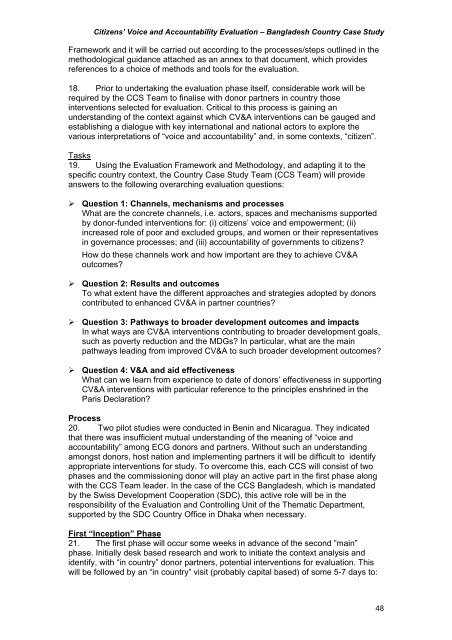Bangladesh - Belgium
Bangladesh - Belgium
Bangladesh - Belgium
Create successful ePaper yourself
Turn your PDF publications into a flip-book with our unique Google optimized e-Paper software.
Citizens’ Voice and Accountability Evaluation – <strong>Bangladesh</strong> Country Case Study<br />
Framework and it will be carried out according to the processes/steps outlined in the<br />
methodological guidance attached as an annex to that document, which provides<br />
references to a choice of methods and tools for the evaluation.<br />
18. Prior to undertaking the evaluation phase itself, considerable work will be<br />
required by the CCS Team to finalise with donor partners in country those<br />
interventions selected for evaluation. Critical to this process is gaining an<br />
understanding of the context against which CV&A interventions can be gauged and<br />
establishing a dialogue with key international and national actors to explore the<br />
various interpretations of “voice and accountability” and, in some contexts, “citizen”.<br />
Tasks<br />
19. Using the Evaluation Framework and Methodology, and adapting it to the<br />
specific country context, the Country Case Study Team (CCS Team) will provide<br />
answers to the following overarching evaluation questions:<br />
‣ Question 1: Channels, mechanisms and processes<br />
What are the concrete channels, i.e. actors, spaces and mechanisms supported<br />
by donor-funded interventions for: (i) citizens’ voice and empowerment; (ii)<br />
increased role of poor and excluded groups, and women or their representatives<br />
in governance processes; and (iii) accountability of governments to citizens?<br />
How do these channels work and how important are they to achieve CV&A<br />
outcomes?<br />
‣ Question 2: Results and outcomes<br />
To what extent have the different approaches and strategies adopted by donors<br />
contributed to enhanced CV&A in partner countries?<br />
‣ Question 3: Pathways to broader development outcomes and impacts<br />
In what ways are CV&A interventions contributing to broader development goals,<br />
such as poverty reduction and the MDGs? In particular, what are the main<br />
pathways leading from improved CV&A to such broader development outcomes?<br />
‣ Question 4: V&A and aid effectiveness<br />
What can we learn from experience to date of donors’ effectiveness in supporting<br />
CV&A interventions with particular reference to the principles enshrined in the<br />
Paris Declaration?<br />
Process<br />
20. Two pilot studies were conducted in Benin and Nicaragua. They indicated<br />
that there was insufficient mutual understanding of the meaning of “voice and<br />
accountability” among ECG donors and partners. Without such an understanding<br />
amongst donors, host nation and implementing partners it will be difficult to identify<br />
appropriate interventions for study. To overcome this, each CCS will consist of two<br />
phases and the commissioning donor will play an active part in the first phase along<br />
with the CCS Team leader. In the case of the CCS <strong>Bangladesh</strong>, which is mandated<br />
by the Swiss Development Cooperation (SDC), this active role will be in the<br />
responsibility of the Evaluation and Controlling Unit of the Thematic Department,<br />
supported by the SDC Country Office in Dhaka when necessary.<br />
First “Inception” Phase<br />
21. The first phase will occur some weeks in advance of the second ”main”<br />
phase. Initially desk based research and work to initiate the context analysis and<br />
identify, with “in country” donor partners, potential interventions for evaluation. This<br />
will be followed by an “in country” visit (probably capital based) of some 5-7 days to:<br />
48

















